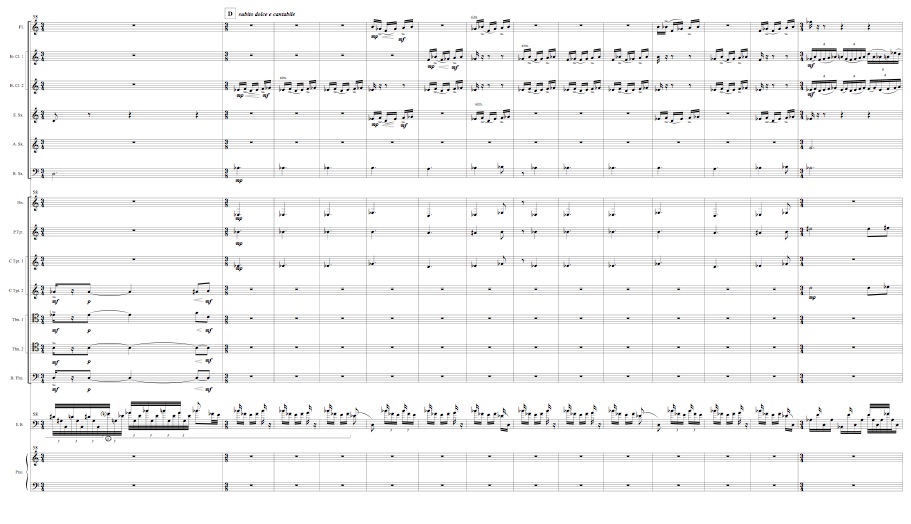Concerto for Bass Guitar (2002) 19’
(Four Imaginary Views of the Sagrada Familia)
fl 2cl 3sax 3trpt 3 trb hrn pno solo-bass guit. electronics (CD)
I. West Facade - II. North Facade: Sepulture (including Gaudi's Death) - III. Scherzo - South Facade - IV. Not Of This World: East Facade
written for: Orkest De Volharding
first performance: by Orkest De Volharding; F.M.Maier, bass guitar, Amsterdam, march 2003
performed since: in the Netherlands by Orkest De Volharding
Commissioned by the Fonds Scheppende Toonkunst.
“sympathetic [...] a mixture of Death Metal and Petrushka [...] this composer clearly knows what he’s doing”
(-Het Parool, 21.3.2003)
This Concerto is entirely inspired by, based on and constructed according to the plans and sketches for Antoni Gaudi’s Expiatory Temple of the Sagrada Familia in Barcelona, the most famous and striking example of expressionistic (some call it transcendental) architecture, and one of the most daring architectonic endeavours ever. Since, after more than a century of construction, only a fraction of the Temple exists for real, one has to rely on one’s imagination and the drawings exhibited in the Temple’s own museum, photographs of which are enclosed at the back of the score.
The piece is an imaginary stroll around the completed building; its proportions, structure and characters are a literal translation of the architectonic model. As the church has the skeleton of a more or less “normal” Spanish-Gothic cathedral, which is masked and surpassed with expressionistic and often surrealistic elements (like giant pomegrenades, invertebrae from stone crawling up the towers, absurd amounts of minarets or a gigantic fractal interior in psychedelically coloured concrete), the concerto uses the romantic 4-movement concerto form and a Spanish-influenced idiom as a departure point, but imposes on it the surrealistic choice of the bass guitar as the solo instrument, an un-classical accompanying ensemble with electronics and contemporary esthetics. As far as can be judged from the sketches and the construction site in Barcelona, each facade is distinctly different from the others in its character.
The West Facade is majestic and clear; post-Gaudi straight (but nevertheless tilted) lines all unite in pointing skywards. If seen directly from below, the spiral staircases of the towers look like the whorl of a snail-shell, endlessly winding upwards; this is depicted in the ensemble in rapidly modulating, spiral-shaped scales and arpeggios.
In the second movement, the more-Gothic-than-Gothic North Facade gives the bass guitar a chance to show its finer side as it climbs up in very high registers according to the ethereal face of the church’s North side. Its 23 major towers are translated by the two clarinets. In the drum machine (electronics), the perspectivically branching pattern of pillars in the interior is literally filled in with drum samples, their sounds, registers and tempi corresponding with the thickness, height and distance of the pillars. Since Gaudi talks about imitating nature (in this case trees) in his buildings, the layers in the drum machine increase in complexity until an organic, forest-liked soundscape is created. This movement, subtitled Sepulture, mourns Gaudi’s premature death (he got hit by a street car while looking at his church) in the slightly absurd way which is to be expected, with two trumpets, a low ffff-cluster in the piano and the third movement hitting like a ton of bricks.
Because the South Facade is the exact opposite of the North facade - seven heavy-set main towers (acoustically symbolized by the trombones) and megalomaniacal clouds and tongues of concrete in joyful colours, the musical contrast with the second movement is as great as possible, and the South Facade is suitable for being the scherzo, alternating between heavy magnification of the bass part in the ensemble (beginning, ending) and crooked counterpoint in the polymetric double fugue which dominates the central section. The cadenza at the end of this movement presents a denaturalized flamenco bass guitar with virtual footwork and tablas.
The East Facade looks most impressive already in its partially constructed form, and is unusual even in the temple’s own context - it looks like a remnant of an extraterrestrial civilization, and its excessive ornamentation and melted shape make it hard to believe that one is looking at a building and not a painting from the cosmos of Hieronimus Bosch; hence the last movement’s title Not Of This World. More free in form, it is an independent piece within the strict formal arch of the whole concerto; the ending serves as a recapitulation and exit of the piece.
This piece is dedicated to all bass players.
listen: Bassconcerto Clip!watch: I II+III IV

